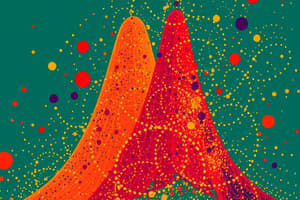Podcast
Questions and Answers
What is the main difference between Random Sampling and Non-Random Sampling?
What is the main difference between Random Sampling and Non-Random Sampling?
Random Sampling: Every unit of the population has the same probability of being included in the sample. Non-Random Sampling: Every unit of the population does not have the same probability of being included in the sample.
What is an example of Random Sampling given in the text?
What is an example of Random Sampling given in the text?
The teacher asking students to write their names on a piece of paper, placing them in a box, and then randomly choosing a student for an oral recitation.
What are the different types of Non-Random Sampling mentioned in the text?
What are the different types of Non-Random Sampling mentioned in the text?
Convenience Sampling, Quota Sampling, Purposive Sampling, Snowball Sampling
What is Slovin's Formula used for?
What is Slovin's Formula used for?
What are the components of Slovin's Formula?
What are the components of Slovin's Formula?
In the given example, what is the sample size required for a population of 2,000 with a 97% confidence level?
In the given example, what is the sample size required for a population of 2,000 with a 97% confidence level?
What is a probability distribution of a discrete random variable?
What is a probability distribution of a discrete random variable?
What should be the range of all probabilities in a probability distribution?
What should be the range of all probabilities in a probability distribution?
How is the mean of a discrete random variable defined?
How is the mean of a discrete random variable defined?
What do the variance and standard deviation describe in a probability distribution?
What do the variance and standard deviation describe in a probability distribution?
What is the formula for computing the variance of a discrete random variable?
What is the formula for computing the variance of a discrete random variable?
What is the relationship between the sum of all probabilities in a probability distribution and the value 1?
What is the relationship between the sum of all probabilities in a probability distribution and the value 1?
What is simple random sampling?
What is simple random sampling?
Why is defining the population important in simple random sampling?
Why is defining the population important in simple random sampling?
What is a sampling frame?
What is a sampling frame?
How do you determine the sample size in simple random sampling?
How do you determine the sample size in simple random sampling?
What is the final step in simple random sampling after collecting data?
What is the final step in simple random sampling after collecting data?
What is a key advantage of simple random sampling in terms of representation?
What is a key advantage of simple random sampling in terms of representation?
What is a random experiment?
What is a random experiment?
Define outcome in the context of a random experiment.
Define outcome in the context of a random experiment.
Explain what a sample space is.
Explain what a sample space is.
What is a random variable?
What is a random variable?
Differentiate between a discrete and a continuous random variable.
Differentiate between a discrete and a continuous random variable.
Give an example of a discrete random variable.
Give an example of a discrete random variable.
What is the purpose of using Two-Stage Sampling?
What is the purpose of using Two-Stage Sampling?
Describe the process of Multi-Stage Sampling.
Describe the process of Multi-Stage Sampling.
In the example provided of conducting a customer survey, what is the chosen cluster for selection?
In the example provided of conducting a customer survey, what is the chosen cluster for selection?
What is the purpose of conducting Stratified Sampling?
What is the purpose of conducting Stratified Sampling?
Why is Stratified Sampling considered to be more complex than simple random sampling?
Why is Stratified Sampling considered to be more complex than simple random sampling?
What is the key difference between Two-Stage Sampling and Multi-Stage Sampling?
What is the key difference between Two-Stage Sampling and Multi-Stage Sampling?



